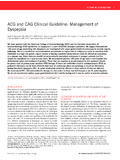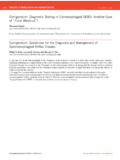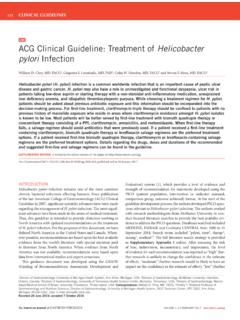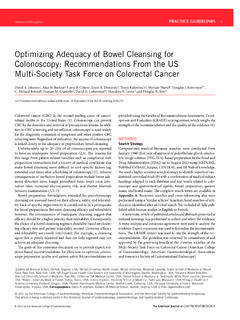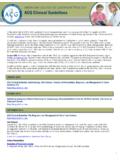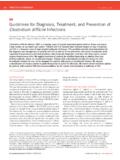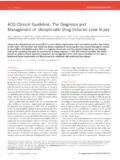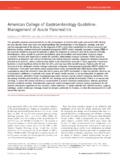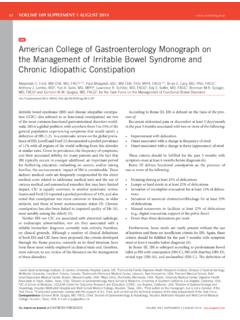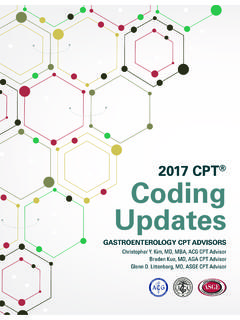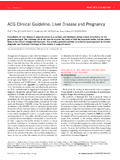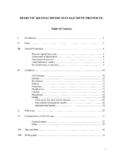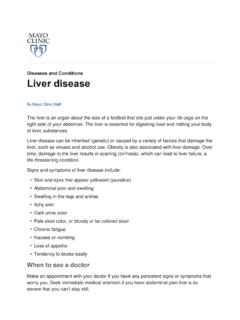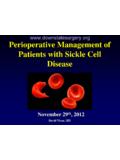Transcription of ACG Clinical Guidelines: Diagnosis and …
1 656 PRACTICE guidelines nature publishing group CME. ACG Clinical guidelines : Diagnosis and management of Celiac Disease Alberto Rubio-Tapia, MD1, Ivor D. Hill, MD2, Ciar n P. Kelly, MD3, Audrey H. Calderwood, MD4 and Joseph A. Murray, MD1. This guideline presents recommendations for the Diagnosis and management of patients with celiac disease. Celiac disease is an immune-based reaction to dietary gluten (storage protein for wheat, barley, and rye) that primarily affects the small intestine in those with a genetic predisposition and resolves with exclusion of gluten from the diet.
2 There has been a substantial increase in the prevalence of celiac disease over the last 50 years and an increase in the rate of Diagnosis in the last 10 years. Celiac disease can present with many symptoms, including typical gastrointestinal symptoms ( , diarrhea, steatorrhea, weight loss, bloating, flatulence, abdominal pain) and also non-gastrointestinal abnormalities ( , abnormal liver function tests, iron deficiency anemia, bone disease, skin disorders, and many other protean manifestations). Indeed, many individuals with celiac disease may have no symptoms at all.
3 Celiac disease is usually detected by serologic testing of celiac-specific antibodies. The Diagnosis is confirmed by duodenal mucosal biopsies. Both serology and biopsy should be performed on a gluten- containing diet. The treatment for celiac disease is primarily a gluten-free diet (GFD), which requires significant patient education, motivation, and follow-up. Non-responsive celiac disease occurs frequently, particularly in those diagnosed in adulthood. Persistent or recurring symptoms should lead to a review of the patient's original Diagnosis to exclude alternative diagnoses, a review of the GFD to ensure there is no obvious gluten contamination, and serologic testing to confirm adherence with the GFD.
4 In addition, evaluation for disorders associated with celiac disease that could cause persistent symptoms, such as microscopic colitis, pancreatic exocrine dysfunction, and complications of celiac disease, such as enteropathy-associated lymphoma or refractory celiac disease, should be entertained. Newer therapeutic modalities are being studied in Clinical trials, but are not yet approved for use in practice. Given the incomplete response of many patients to a GFD-free diet as well as the difficulty of adherence to the GFD over the long term, development of new effective therapies for symptom control and reversal of inflammation and organ damage are needed.
5 The prevalence of celiac disease is increasing worldwide and many patients with celiac disease remain undiagnosed, highlighting the need for improved strategies in the future for the optimal detection of patients. Am J Gastroenterol 2013; 108:656 676; ; published online 16 April 2013. INTRODUCTION the negatives and the result of no action. Conditional is used This Clinical guideline addresses the Diagnosis , treatment, and when some uncertainty remains about the balance of benefit/. overall management of patients with celiac disease (CD), includ- potential harm.
6 The quality of the evidence is graded from ing an approach to the evaluation of non-responsive CD. While high to low. High -quality evidence indicates that further it is primarily directed at the care of adult patients, variations research is unlikely to change the authors' confidence in the pertinent to the pediatric population have been included. estimate of effect. Moderate -quality evidence indicates that Each section will provide specific recommendations based further research would be likely to have an impact on the confi- on the current literature and a summary of the evidence support- dence of the estimate, whereas Low -quality evidence indicates ing those recommendations.
7 The GRADE system was used to that further study would likely have an important impact on the evaluate the quality of supporting evidence (1) (Table 1). A strong confidence in the estimate of the effect and would likely change recommendation is made when the benefits clearly outweigh the estimate. 1. Division of Gastroenterology and Hepatology, Mayo Clinic, Rochester, Minnesota, USA; 2 Department of Pediatrics, Wake Forest University School of Medicine, Winston-Salem, North Carolina, USA; 3 Celiac Center, Division of Gastroenterology, Beth Israel Deaconess Medical Center & Harvard Medical School, Boston, Massachusetts, USA; 4 Gastroenterology, Department of Medicine, Boston University School of Medicine, Boston, Massachusetts, USA.
8 Correspondence: Joseph A. Murray, MD, Division of Gastroenterology and Hepatology, Mayo Clinic, 200 1st Street SW, Rochester, Minnesota 55905, USA. E-mail: Received 8 January 2013; accepted 26 February 2013. The American Journal of GASTROENTEROLOGY VOLUME 108 | MAY 2013 Celiac Disease guidelines 657. Table 1. Criteria for assigning grade of evidence (5) CD should be sought among the explanations for elevated serum aminotransferase levels when no other etiology is Type of evidence found. (Strong recommendation, high level of evidence).
9 Randomized trial=high (6) Patients with Type I diabetes mellitus (DM) should be Observational study=low tested for CD if there are any digestive symptoms, or Any other evidence=very low signs, or laboratory evidence suggestive of CD. (Strong recommendation, high level of evidence). Decrease grade if Serious ( 1) or very serious ( 2) limitation to study quality Summary of the evidence. CD is one of the most common caus- Important inconsistency ( 1) es of chronic malabsorption (2). This results from injury to the Some ( 1) or major ( 2) uncertainty about directness small intestine with loss of absorptive surface area, reduction of Imprecise or sparse data ( 1).
10 Digestive enzymes, and consequential impaired absorption of micronutrients such as fat-soluble vitamins, iron, and potentially High probability of reporting bias ( 1). B12 and folic acid (3). In addition, the inflammation exacerbates Increase grade if symptoms of malabsorption by causing net secretion of fluid Strong evidence of association significant relative risk of > 2 ( < ) that can result in diarrhea. The failure of absorption of adequate based on consistent evidence from two or more observational calories leads to weight loss, and the malabsorption results in studies, with no plausible confounders ( + 1).
